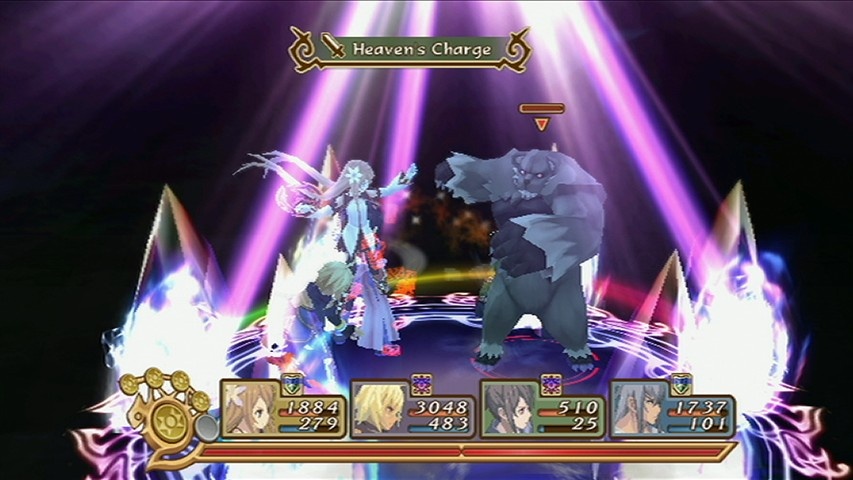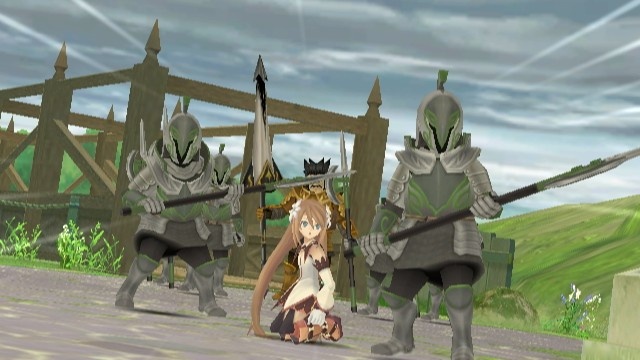Tales of Symphonia: Dawn of the New World is a lighthearted action role-playing game that reacquaints fans of the GameCube original with a wealth of familiar locations and faces. Although those who appreciated its predecessor's lovable characters and fast-paced battle system will undoubtedly be thrilled with New World's striking similarities, the game does little to progress beyond its forbearer aside from adding a superfluous monster-pact system. Additionally, those looking for a greater gameplay-to-cutscene ratio and a clearer, more interesting plot may be baffled by how drastically New World comes up short.
The game returns you to Tethe'alla and Sylvarant, two worlds finally reunited by the birth of a new World Tree. Unfortunately, world regeneration came with a price; the death of the old World Tree has unbalanced the world, causing climate change and crazed monsters to strike every town. Marta, a girl with a special gem, is seeking to restore the balance by awakening Ratatosk, lord of monsters, who should stop the monster attacks and fix the disastrous weather. A young orphan boy named Emil soon joins her in exchange for the power to avenge his parents' death. The duo quickly meets numerous characters from the game's progenitor, but you may be disappointed if you're hoping to play with your favorites, given that you have zero control over who joins or leaves your party. Furthermore, though various plot points and background information are periodically explained, the storyline is an intimidating, convoluted mess.

Exploration is restricted due to the fact that you don't get to do any on the world map, which features straightforward, menu-based navigation from city to city without the hope of random encounters. This switch dramatically increases linearity and also causes a balancing issue because it limits leveling options to dungeons alone. Progressing through the plot too quickly can leave you woefully unprepared for bosses, forcing you to revisit old dungeon haunts and repeat battles to keep up to speed. The dungeons themselves are usually limited to three key areas and pose little challenge, with their sole difficulty stemming from illogical twists and a camera that obscures important puzzle elements or your next destination, which can be maddening.
Battles occur in real time and are mostly button-mashing affairs against easy foes that require almost no strategic planning short of running behind an enemy and slashing it in the back. You simply mash the attack button to perform combos that raise the attack gauge, which enables powerful unison attacks with allies. Artes, the game's special attack and magic system, include a healthy slew of options for those who enjoy spamming devastating magic between extensive combo strings. Your AI teammates are usually intelligent enough to back you up, but when their behavior turns idiotic, you may have to issue tactical orders via the battle menu. What's disappointing is that you're unable to set general targets for your party; this lack is quite vexing when you encounter healing enemies because it's impossible for you to order your teammates to attack the healer, and battles are significantly lengthened as a result. You can also combat your party's stupidity by switching between allies, thereby seizing direct control, or by enlisting up to three friends to follow your lead, which is great fun and eliminates any targeting fuss.
The new pact system offers a refreshing twist to the battle system but quickly becomes irksome and meaningless. Each battlefield emphasizes an elemental grid consisting of one primary and five secondary elements; to form a pact with a monster to enlist its services, you must defeat it by matching the primary to four of the secondary elements via artes, which have elemental attributes. This can be a very frustrating process because your initial access to artes is limited; it's also difficult to keep your allies from adjusting the grid without ordering them to stand down, but it gets easier as you acquire more artes. You may even find yourself accidentally befriending monsters, of which you can store more than 200. Unfortunately, forming pacts is largely unnecessary because you quickly gain more-powerful human allies and rarely travel without them, which makes monster hunting a moot point.
A few miscellaneous features provide a miniscule amount of depth, including side quests activated at the katz guild, though most of these are short, boring adventures that restrict you from saving the game until they're finished. There is an item-synthesis system for turning the most banal of objects into awe-inspiring gear, but money and items are so easy to come by that it should be of interest only to item enthusiasts. Cooking is paired with the pact system to enable you to feed your monsters, which improves their stats and may even evolve them into a tougher form, but on the whole you're left with little other than trivial side quests and needless monster management to pass the time.

Although the game is graphically superior to its GameCube predecessor, it's still only mediocre visually; the character design isn't as adorable as the original's cel-shaded style, and jaggy edges haunt many an environmental object. Fortunately, a vivid color palette and flashy spell effects keep things lively and are supported with soothing village tunes and the traditional fake rock battle music typical of the genre. Cutscenes, the staple of the Tales franchise, are perhaps the game's most bothersome aspect because their overemphasis constantly interrupts the flow of play. Gameplay is plagued by annoying flashbacks or lengthy discussions in which characters repeat full lines of chatter to reinforce the simplest of objectives. Likewise, optional party-member chat skits, which provide character insights if you're lucky, more often than not culminate in cliche cooking comments and romantic quips. Cutscenes and skits are frequently spaced back to back within mere footsteps of each other, and the annoying, exaggerated voicing only accentuates the poor, cheesy dialogue, though there is an option to turn voice-overs off.
You should barrel through the eight chapters in about 30 hours, but much of this time is spent enduring lengthy, cliche cutscenes or engaging in tiresome leveling sessions at previously completed dungeons. You could up the play time significantly by acquiring items for synthesis, completing all side quests, and collecting every monster, but it's much more fun to take advantage of the four-person multiplayer, though it's still restricted to battles.
Tales of Symphonia: Dawn of the New World should be enjoyed by anyone who appreciated its progenitor's unique characters, but its overwhelming amount of distracting cutscenes, overbearing linearity, pointless pact system, and general lack of depth severely limit its appeal.
Editor's Note: This review previously stated that cutscenes cannot be skipped, which they actually can be by holding down the A and B buttons simultaneously. GameSpot regrets the error.